Powder Metallurgical Processing of Sn-Reinforced Al-Cu-Fe Quasicrystals: Structure, Microstructure and Toughening Behavior
Abstract
1. Introduction
2. Experimental Details
3. Results
4. Discussions
5. Conclusions
- After milling, the Al-Cu-Fe IQC phase transforms to the Al13Fe4 and B2-type Al (Cu, Fe) phases. However, the phase fraction of Al13Fe4 and B2-type phases formed after MM is dependent on the volume fraction of Sn reinforcement in the IQC-Sn nanocomposite powder.
- The structural transformation and grain refinement induced during milling affect the indentation behavior and microhardness of IQC-Sn nanocomposite powders. The microhardness in these milled powders can be tuned in the range of ~5.2 to 7.3 GPa.
- The IQC-Sn bulk composite prepared through hot pressing increases microhardness and fracture toughness.
- The microhardness of the hot-pressed sample (IQC-10Sn-HP) at 200 g load was found to be ~9.2 GPa. However, the pressureless-sintered composite has a lower microhardness value than that of the hot-pressed sample at a 200 g load.
- The overall increase in the fracture toughness of IQC-10Sn-HP composite was ~22% due to the significant reduction in the indentation crack length (~15 µm). This reduction in the crack length was attributed to Sn particles’ homogenous distribution in the IQC matrix, enhancing its propensity to arrest the cracks. This offers the possibility of synthesizing nanocomposite powders and bulk composite by HP and pressureless sintering, having an optimal combination of microhardness and fracture toughness required as feedstock for coating applications.
Supplementary Materials
Author Contributions
Funding
Data Availability Statement
Acknowledgments
Conflicts of Interest
References
- Shechtman, D.; Blech, I.; Gratias, D.; Cahn, J.W. Metallic Phase with Long-Range Orientational Translational Symmetry. Phys. Rev. Lett. 1984, 53, 1951–1954. [Google Scholar] [CrossRef]
- Pandey, V.K.; Shadangi, Y.; Shivam, V.; Sarma, B.; Mukhopadhyay, N. Theoretical and experimental study on phase stability of TiVZrMoW refractory high entropy alloy. Philos. Mag. 2021, 102, 480–503. [Google Scholar] [CrossRef]
- Singh, N.; Shadangi, Y.; Goud, G.S.; Pandey, V.K.; Shivam, V.; Mukhopadhyay, N.K. Fabrication of MgAlSiCrFe Low-Density High-Entropy Alloy by Mechanical Alloying and Spark Plasma Sintering. Trans. Indian Inst. Met. 2021, 74, 2203–2219. [Google Scholar] [CrossRef]
- Mukhopadhyay, N.; Belger, A.; Paufler, P.; Kim, D. Nanoindentation studies on Cu–Ti–Zr–Ni–Si–Sn bulk metallic glasses. Mater. Sci. Eng. A 2007, 449–451, 954–957. [Google Scholar] [CrossRef]
- Chaubey, A.; Scudino, S.; Khoshkhoo, M.S.; Prashanth, K.; Mukhopadhyay, N.; Mishra, B.; Eckert, J. High-strength ultrafine grain Mg–7.4%Al alloy synthesized by consolidation of mechanically alloyed powders. J. Alloys Compd. 2014, 610, 456–461. [Google Scholar] [CrossRef]
- Chaubey, A.K.; Scudino, S.; Khoshkhoo, M.S.; Prashanth, K.G.; Mukhopadhyay, N.K.; Mishra, B.K.; Eckert, J. Synthesis and Characterization of NanocrystallineMg-7.4%Al Powders Produced by Mechanical Alloying. Metals 2013, 3, 58–68. [Google Scholar] [CrossRef]
- Huttunen-Saarivirta, E. Microstructure, fabrication and properties of quasicrystalline Al–Cu–Fe alloys: A review. J. Alloys Compd. 2004, 363, 154–178. [Google Scholar] [CrossRef]
- Huttunen-Saarivirta, E.; Turunen, E.; Kallio, M. Microstructural characterisation of thermally sprayed quasicrystalline Al–Co–Fe–Cr coatings. J. Alloys Compd. 2003, 354, 269–280. [Google Scholar] [CrossRef]
- Mukhopadhyay, N.K.; Yadav, T.P. Quasicrystals: A New Class of Structurally Complex Intermetallics. J. Indian Inst. Sci. 2022, 1–32. [Google Scholar] [CrossRef]
- Yadav, T.; Mukhopadhyay, N. Quasicrystal: A low-frictional novel material. Curr. Opin. Chem. Eng. 2018, 19, 163–169. [Google Scholar] [CrossRef]
- Dubois, J.-M. Properties- and applications of quasicrystals and complex metallic alloys. Chem. Soc. Rev. 2012, 41, 6760–6777. [Google Scholar] [CrossRef] [PubMed]
- Yadav, T.; Mukhopadhyay, N.; Tiwari, R.; Srivastava, O. Studies on the formation and stability of nano-crystalline Al50Cu28Fe22 alloy synthesized through high-energy ball milling. Mater. Sci. Eng. A 2005, 393, 366–373. [Google Scholar] [CrossRef]
- Srivastava, V.C.; Uhlenwinkel, V.; Schulz, A.; Zoch, H.-W.; Mukhopadhyay, N.K.; Chowdhury, S.G. Synthesis of single phase i-AlCuFe bulk quasicrystal by spray forming. Z. Krist. 2008, 223, 711–715. [Google Scholar] [CrossRef]
- Yadav, T.; Mishra, S.; Pandey, S.; Singh, D.; Lowe, M.; Tamura, R.; Mukhopadhyay, N.; Srivastava, O.; McGrath, R.; Sharma, H. Leaching of Al-Based Polygrain Quasicrystalline and Related Crystalline Surfaces. Acta Phys. Pol. A 2014, 126, 629–632. [Google Scholar] [CrossRef]
- Steurer, W.; Deloudi, S. Crystallography of Quasicrystals, 1st ed.; Springer: Berlin/Heidelberg, Germany, 2009. [Google Scholar]
- Stagno, V.; Bindi, L.; Shibazaki, Y.; Tange, Y.; Higo, Y.; Mao, H.-K.; Steinhardt, P.; Fei, Y. Icosahedral AlCuFe quasicrystal at high pressure and temperature and its implications for the stability of icosahedrite. Sci. Rep. 2014, 4, 5869. [Google Scholar] [CrossRef] [PubMed]
- Bindi, L.; Steinhardt, P.J.; Yao, N.; Lu, P.J. Natural Quasicrystals. Science 2009, 324, 1306–1309. [Google Scholar] [CrossRef]
- Mukhopadhyay, N.K.; Ranganathan, S.; Chattopadhyay, K. Evolution of superlattice order in Al–Mn quasicrystals and its relation to face-centred icosahedral quasicrystals. Philos. Mag. Lett. 1989, 60, 207–211. [Google Scholar] [CrossRef]
- Tsai, A.-P.; Inoue, A.; Masumoto, T. Preparation of a new Al-Cu-Fe quasicrystal with large grain sizes by rapid solidification. J. Mater. Sci. Lett. 1987, 6, 1403–1405. [Google Scholar] [CrossRef]
- Srivastava, V.; Huttunen-Saarivirta, E.; Cui, C.; Uhlenwinkel, V.; Schulz, A.; Mukhopadhyay, N. Bulk synthesis by spray forming of Al–Cu–Fe and Al–Cu–Fe–Sn alloys containing a quasicrystalline phase. J. Alloys Compd. 2014, 597, 258–268. [Google Scholar] [CrossRef]
- Shadangi, Y.; Sharma, S.; Shivam, V.; Basu, J.; Chattopadhyay, K.; Majumdar, B.; Mukhopadhyay, N. Fabrication of Al–Cu–Fe quasicrystal reinforced 6082 aluminium matrix nanocomposites through mechanical milling and spark plasma sintering. J. Alloys Compd. 2020, 828, 154258. [Google Scholar] [CrossRef]
- Yadav, T.P.; Woellner, C.F.; Sharifi, T.; Sinha, S.K.; Qu, L.-L.; Apte, A.; Mukhopadhyay, N.K.; Srivastava, O.N.; Vajtai, R.; Galvão, D.S.; et al. Extraction of Two-Dimensional Aluminum Alloys from Decagonal Quasicrystals. ACS Nano 2020, 14, 7435–7443. [Google Scholar] [CrossRef] [PubMed]
- Yadav, T.P.; Woellner, C.F.; Sinha, S.K.; Sharifi, T.; Apte, A.; Mukhopadhyay, N.K.; Srivastava, O.N.; Vajtai, R.; Galvao, D.S.; Tiwary, C.S.; et al. Liquid Exfoliation of Icosahedral Quasicrystals. Adv. Funct. Mater. 2018, 28, 1801181. [Google Scholar] [CrossRef]
- Mishra, S.; Yadav, T.; Mukhopadhyay, N.; Srivastava, O. Synthesis of fine skeletal structure on Al–Cu–Co decagonal quasicrystals for hydrogen production through steam reforming of methanol. Int. J. Hydrogen Energy 2020, 45, 24491–24501. [Google Scholar] [CrossRef]
- Mukhopadhyay, N.K.; Ali, F.; Scudino, S.; Khoshkhoo, M.S.; Stoica, M.; Srivastava, V.C.; Uhlenwinkel, V.; Vaughan, G.; Suryanarayana, C.; Eckert, J. Grain size softening effect in Al62.5Cu25Fe12.5 nanoquasicrystals. Appl. Phys. Lett. 2013, 103, 201914. [Google Scholar] [CrossRef]
- Rawat, R.; Tiwari, A.; Arun, N.; Rao, S.N.; Pathak, A.; Shadangi, Y.; Mukhopadhyay, N.; Tripathi, A. Nanosecond pulsed laser ablation of Al–Cu–Fe quasicrystalline material: Effects of solvent and fluence. J. Alloys Compd. 2020, 859, 157871. [Google Scholar] [CrossRef]
- Singh, A.; Tsai, A.P. Melting behaviour of lead and bismuth nano-particles in quasicrystalline matrix—The role of interfaces. Sadhana Acad. Proc. Eng. Sci. 2003, 28, 63–80. [Google Scholar] [CrossRef][Green Version]
- Singh, A.; Somekawa, H.; Matsushita, Y.; Tsai, A. Solidification of tin on quasicrystalline surfaces. Philos. Mag. 2012, 92, 1106–1128. [Google Scholar] [CrossRef]
- Singh, A.; Tsai, A. Heterogeneous nucleation of lead on quasicrystals. Philos. Mag. Lett. 1998, 77, 89–94. [Google Scholar] [CrossRef]
- Yadav, T.; Singh, D.; Tiwari, R.; Srivastava, O. Enhanced microhardness of mechanically activated carbon–quasicrystal composite. Mater. Lett. 2012, 80, 5–8. [Google Scholar] [CrossRef]
- Patiño-Carachure, C.; Flores-Chan, J.; Gil, A.F.; Rosas, G. Synthesis of onion-like carbon-reinforced AlCuFe quasicrystals by high-energy ball milling. J. Alloys Compd. 2016, 694, 46–50. [Google Scholar] [CrossRef]
- Tsai, A. Metallurgy of Quasicrystals: Alloys and Preparation. MRS Bull. 1997, 22, 43–47. [Google Scholar] [CrossRef]
- Barua, P.; Murty, B.; Srinivas, V. Mechanical alloying of Al–Cu–Fe elemental powders. Mater. Sci. Eng. A 2001, 304–306, 863–866. [Google Scholar] [CrossRef]
- Murty, B.; Barua, P.; Srinivas, V.; Schurack, F.; Eckert, J. Synthesis of (Al65Cu20Fe15)100−xSix quasicrystalline alloys by mechanical alloying. J. Non-Cryst. Solids 2004, 334–335, 44–47. [Google Scholar] [CrossRef]
- Barua, P.; Murty, B.S.; Mathur, B.K.; Srinivas, V. On icosahedral phase formation in mechanically alloyed Al70Cu20Fe10. Mater. Sci. Eng. A 2000, 294–296, 65–67. [Google Scholar] [CrossRef]
- Yadav, T.; Mukhopadhyay, N.; Tiwari, R.; Srivastava, O. On the evolution of quasicrystalline and crystalline phases in rapidly quenched Al-Co–Cu–Ni alloy. Mater. Sci. Eng. A 2007, 449–451, 1052–1056. [Google Scholar] [CrossRef][Green Version]
- Mukhopadhyay, N.K.; Yadav, T.P.; Tiwari, R.S.; Srivastava, O.N. Synthesis of nanocrystalline spinel phase by mechanical milling of Al–Cu–Fe and Al–Cu–Cr–Fe quasicrystalline alloys. Z. Krist. 2008, 223, 716–720. [Google Scholar] [CrossRef]
- Mukhopadhyay, N.K.; Yadav, T.P. Some Aspects of Stability and Nanophase Formation in Quasicrystals during Mechanical Milling. Isr. J. Chem. 2011, 51, 1185–1196. [Google Scholar] [CrossRef]
- Barua, P.; Srinivas, V.; Murty, B.S. Synthesis of quasicrystalline phase by mechanical alloying of Al70Cu20Fe10. Philos. Mag. A 2000, 80, 1207–1217. [Google Scholar] [CrossRef]
- Schurack, F.; Eckert, J.; Schultz, L. Synthesis and mechanical properties of mechanically alloyed Al-Cu-Fe quasicrystalline composites. Philos. Mag. 2003, 83, 1287–1305. [Google Scholar] [CrossRef]
- Tiwari, R.S.; Yadav, T.P.; Mukhopadhyay, N.K.; Abu Shaz, M.; Srivastava, O.N. Nanocrystallization and structural correlation in quasicrystalline and crystalline phases during mechanical milling. Z. Krist. 2009, 224, 26–30. [Google Scholar] [CrossRef]
- Ali, F.; Scudino, S.; Gorantla, S.; Srivastava, V.; Shahid, H.; Uhlenwinkel, V.; Stoica, M.; Vaughan, G.; Mukhopadhyay, N.; Eckert, J. Mechanically driven phase transformation in single phase Al62.5Cu25Fe12.5 quasi-crystals: Effect of milling intensity. Acta Mater. 2013, 61, 3819–3830. [Google Scholar] [CrossRef]
- Mukhopadhyay, N.K.; Yadav, T.P.; Srivastava, O.N. Effects of ball milling and annealing of an alloy in the Al-Fe-Cu system: Implications for phase equilibria. Philos. Mag. Lett. 2003, 83, 423–432. [Google Scholar] [CrossRef]
- Fleury, E.; Kim, Y.-C.; Kim, D.-H.; Kim, W.-T. The toughening of Al–Cu–Fe(-B) quasicrystals by Sn particles. J. Non-Cryst. Solids 2004, 334–335, 449–452. [Google Scholar] [CrossRef]
- Shao, T.; Cao, X.; Fleury, E.; Kim, D.-H.; Hua, M.; Se, D. Tribological behavior of plasma sprayed Al–Cu–Fe+Sn quasicrystalline composite coatings. J. Non-Cryst. Solids 2004, 334–335, 466–470. [Google Scholar] [CrossRef]
- Singh, A.; Somekawa, H.; Tsai, A. Interfaces made by tin with icosahedral phase matrix. Scr. Mater. 2008, 59, 699–702. [Google Scholar] [CrossRef]
- Mukhopadhyay, N.K.; Uhlenwinkel, V.; Srivastava, V.C. Synthesis and Characterization of Bulk Al-Cu-Fe Based Quasicrystals and Composites by Spray Forming. J. Mater. Eng. Perform. 2015, 24, 2172–2178. [Google Scholar] [CrossRef]
- Shadangi, Y.; Shivam, V.; Singh, M.K.; Chattopadhyay, K.; Basu, J.; Mukhopadhyay, N. Synthesis and characterization of Sn reinforced Al-Cu-Fe quasicrystalline matrix nanocomposite by mechanical milling. J. Alloys Compd. 2019, 797, 1280–1287. [Google Scholar] [CrossRef]
- Shadangi, Y.; Shivam, V.; Varalakshmi, S.; Basu, J.; Chattopadhyay, K.; Majumdar, B.; Mukhopadhyay, N. Mechanically driven structural transformation in Sn reinforced Al–Cu–Fe quasicrystalline matrix nanocomposite. J. Alloys Compd. 2020, 834, 155065. [Google Scholar] [CrossRef]
- Singh, N.; Shadangi, Y.; Mukhopadhyay, N.K. Phase Evolution and Thermal Stability of Low-Density MgAlSiCrFe High-Entropy Alloy Processed Through Mechanical Alloying. Trans. Indian Inst. Met. 2020, 73, 2377–2386. [Google Scholar] [CrossRef]
- Singh, N.; Shadangi, Y.; Shivam, V.; Mukhopadhyay, N.K. MgAlSiCrFeNi low-density high entropy alloy processed by mechanical alloying and spark plasma sintering: Effect on phase evolution and thermal stability. J. Alloys Compd. 2021, 875, 159923. [Google Scholar] [CrossRef]
- Pandey, V.K.; Shadangi, Y.; Shivam, V.; Basu, J.; Chattopadhyay, K.; Majumdar, B.; Sarma, B.N.; Mukhopadhyay, N.K. Synthesis, Characterization and Thermal Stability of Nanocrystalline MgAlMnFeCu Low-Density High-Entropy Alloy. Trans. Indian Inst. Met. 2020, 74, 33–44. [Google Scholar] [CrossRef]
- Murthy, G.V.S.; Ray, A.K.; Minz, R.K.; Mukhopadhyay, N.K. Microhardness and Fracture Toughness Studies of Decagonal Quasicrystal in Al-Cu-Co System. J. Mater. Sci. Lett. 1999, 18, 255–258. [Google Scholar] [CrossRef]
- Mukhopadhyay, N.K.; Paufler, P. Micro- and nanoindentation techniques for mechanical characterisation of materials. Int. Mater. Rev. 2006, 51, 209–245. [Google Scholar] [CrossRef]
- Köster, U.; Liebertz, H.; Liu, W. Plastic deformation of quasi-crystalline and crystalline phases in AlCuFe alloys. Mater. Sci. Eng. A 1994, 181–182, 777–780. [Google Scholar] [CrossRef]
- Köster, U.; Liu, W.; Liebertz, H.; Michel, M. Mechanical properties of quasicrystalline and crystalline phases in AlCuFe alloys. J. Non-Cryst. Solids 1993, 153–154, 446–452. [Google Scholar] [CrossRef]
- Kang, S.; Dubois, J.; von Stebut, J. Tribological properties of quasicrystalline coatings. J. Mater. Res. 1993, 8, 2471–2481. [Google Scholar] [CrossRef]
- Mukhopadhyay, N.; Ali, F.; Srivastava, V.; Yadav, T.; Sakaliyska, M.; Surreddi, K.; Scudino, S.; Uhlenwinkel, V.; Eckert, J. Strain-induced structural transformation of single-phase Al–Cu–Fe icosahedral quasicrystal during mechanical milling. Philos. Mag. 2010, 91, 2482–2490. [Google Scholar] [CrossRef]
- Nicula, R.; Turquier, F.; Stir, M.; Kodash, V.; Groza, J.; Burkel, E. Quasicrystal phase formation in Al–Cu–Fe nanopowders during field-activated sintering (FAST). J. Alloys Compd. 2007, 434–435, 319–323. [Google Scholar] [CrossRef]
- Nicula, R.; Stir, M.; Turquier, F.; Burkel, E. Single-phase bulk Al–Cu–Fe quasicrystals by field-assisted sintering. Mater. Sci. Eng. A 2008, 475, 113–116. [Google Scholar] [CrossRef]
- Nicula, R.; Ishizaki, K.; Stir, M.; Shen, Z.; Vaucher, S. Rapid synthesis and densification of single-phase Al–Cu–Fe quasicrystals by spark plasma sintering or microwave heating. Philos. Mag. 2010, 91, 2450–2457. [Google Scholar] [CrossRef]
- Fleury, E.; Lee, J.H.; Kim, S.H.; Kim, W.T.; Kim, J.S.; Kim, D.H. Spark plasma sintering of Al-Si-Cu-Fe quasi-crystalline powder. Met. Mater. Trans. A 2003, 34, 841–849. [Google Scholar] [CrossRef]
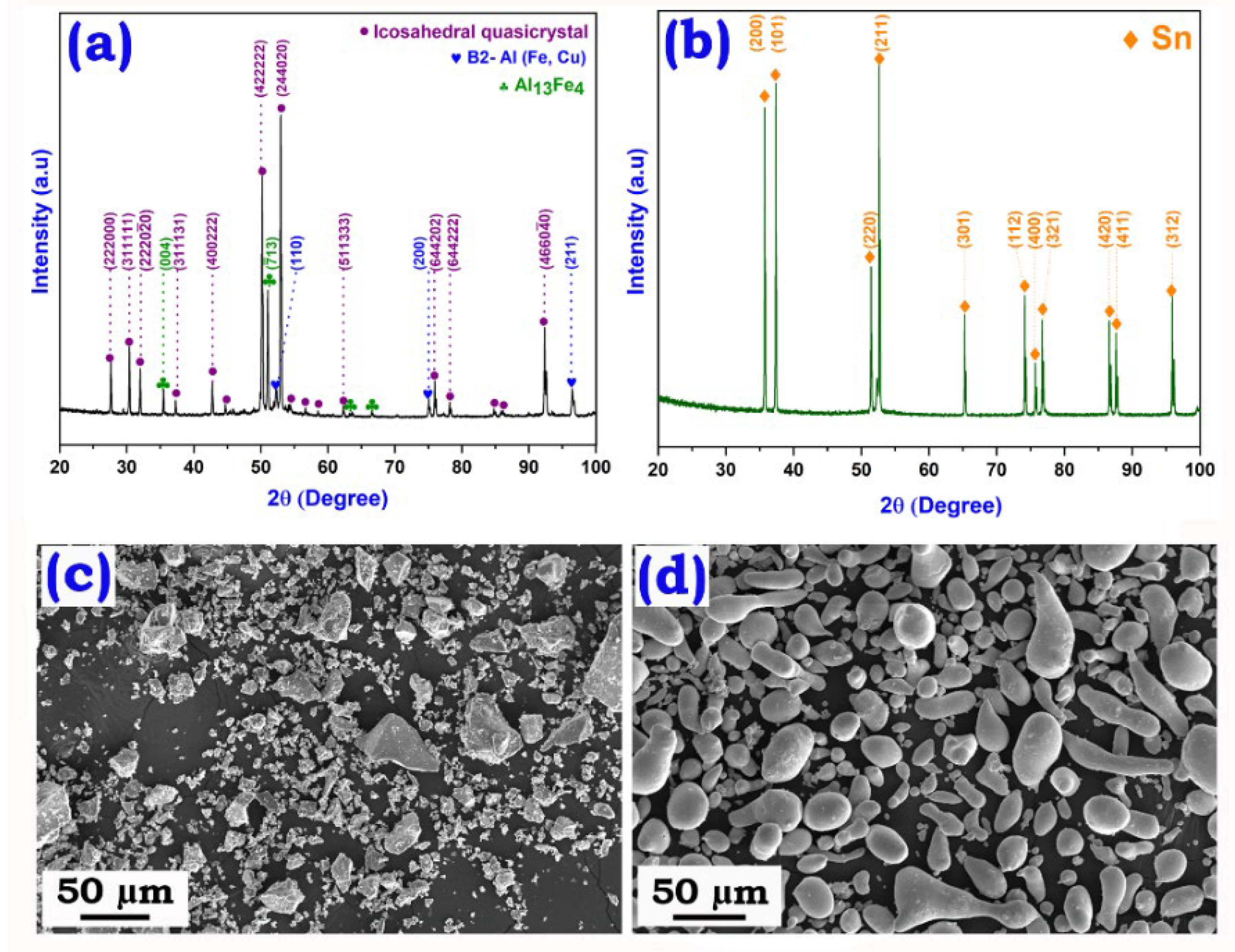
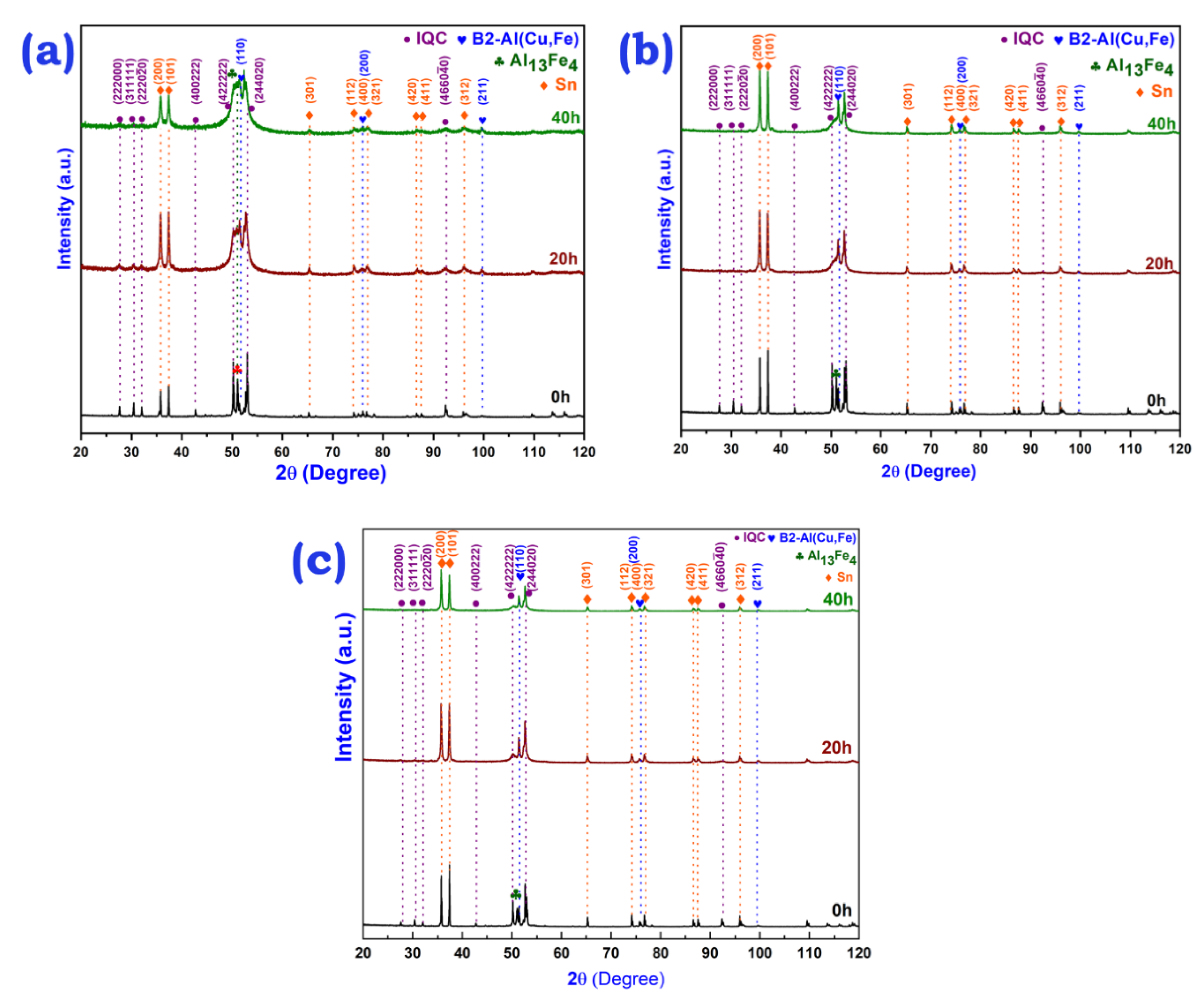
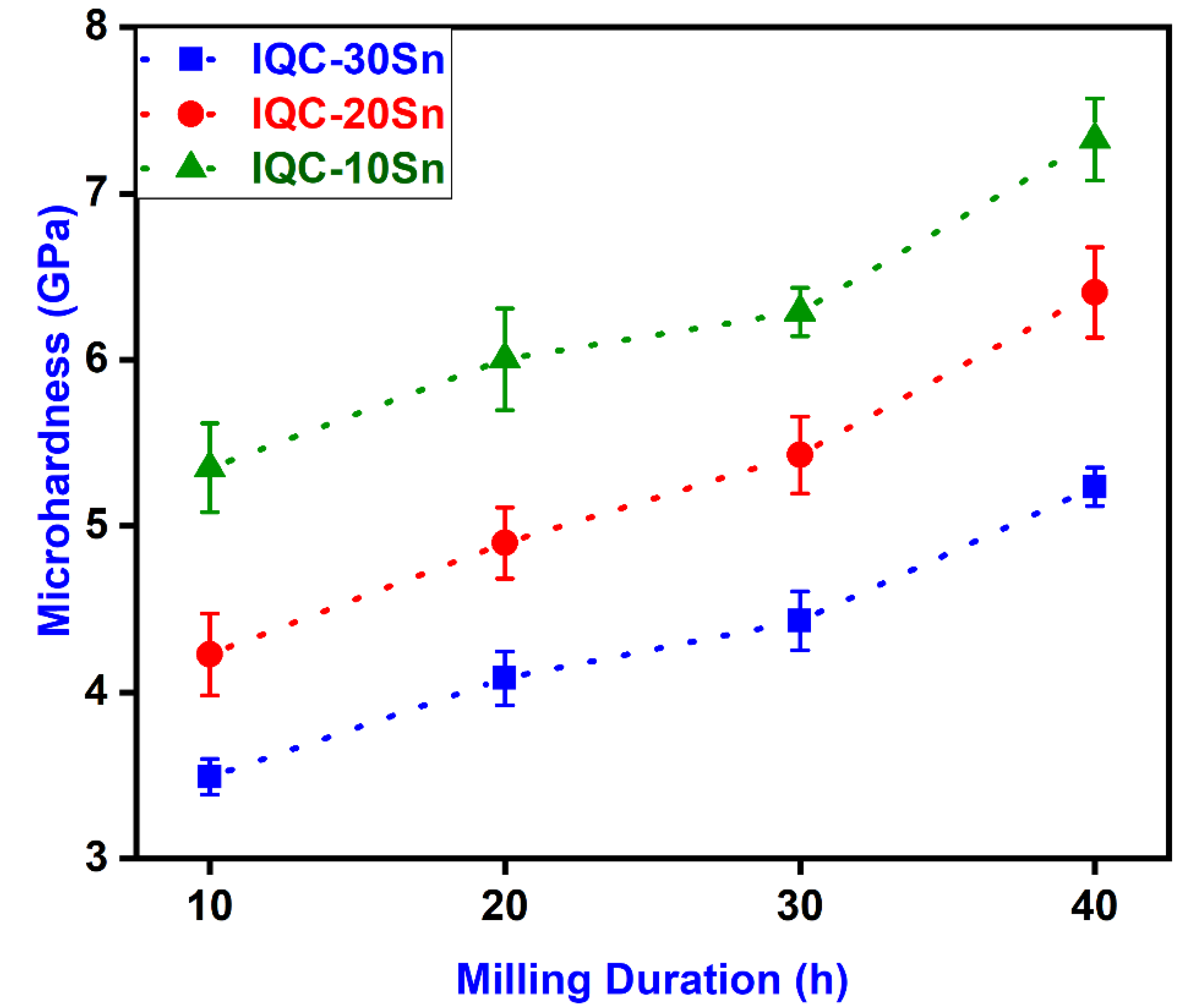
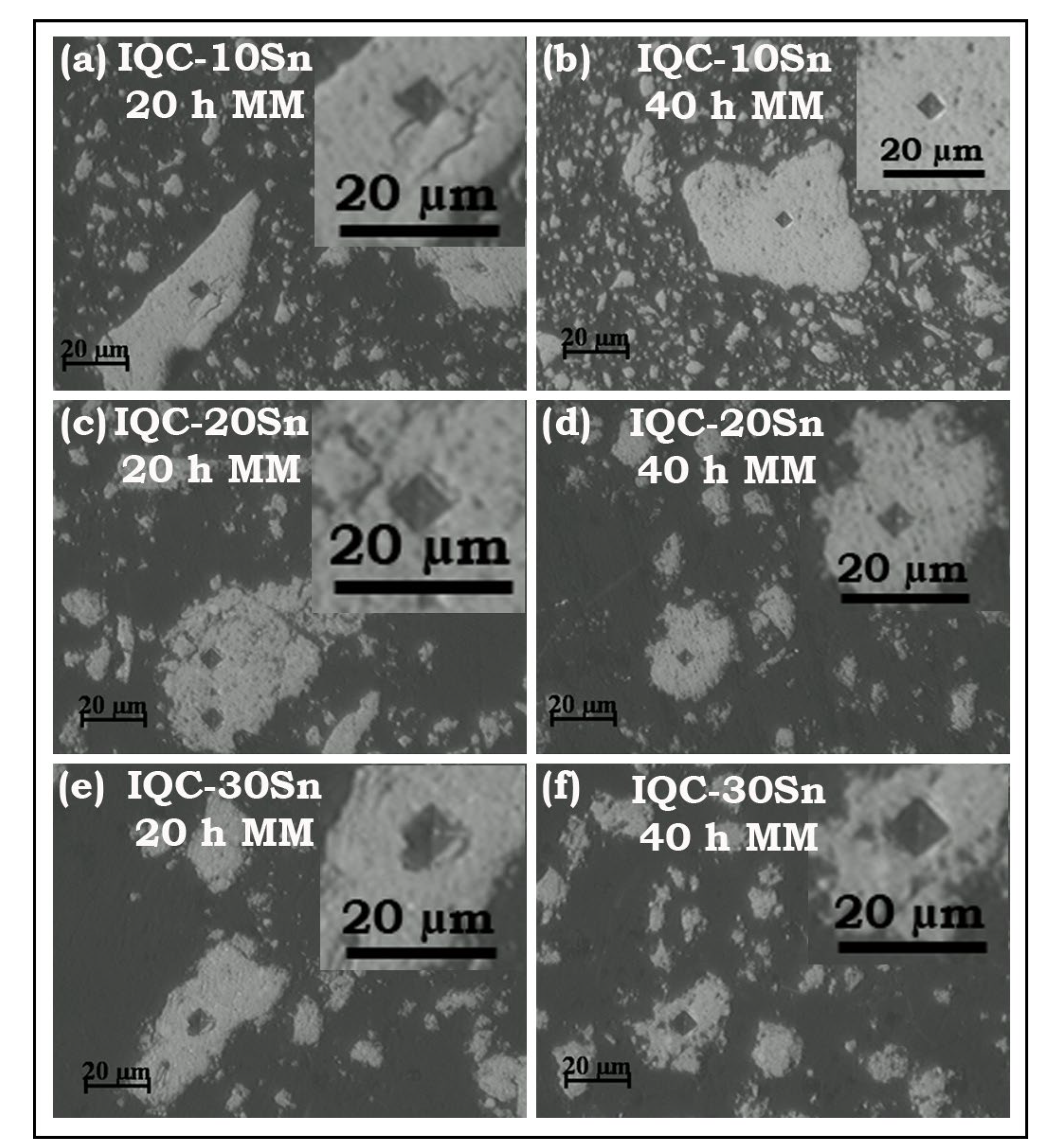
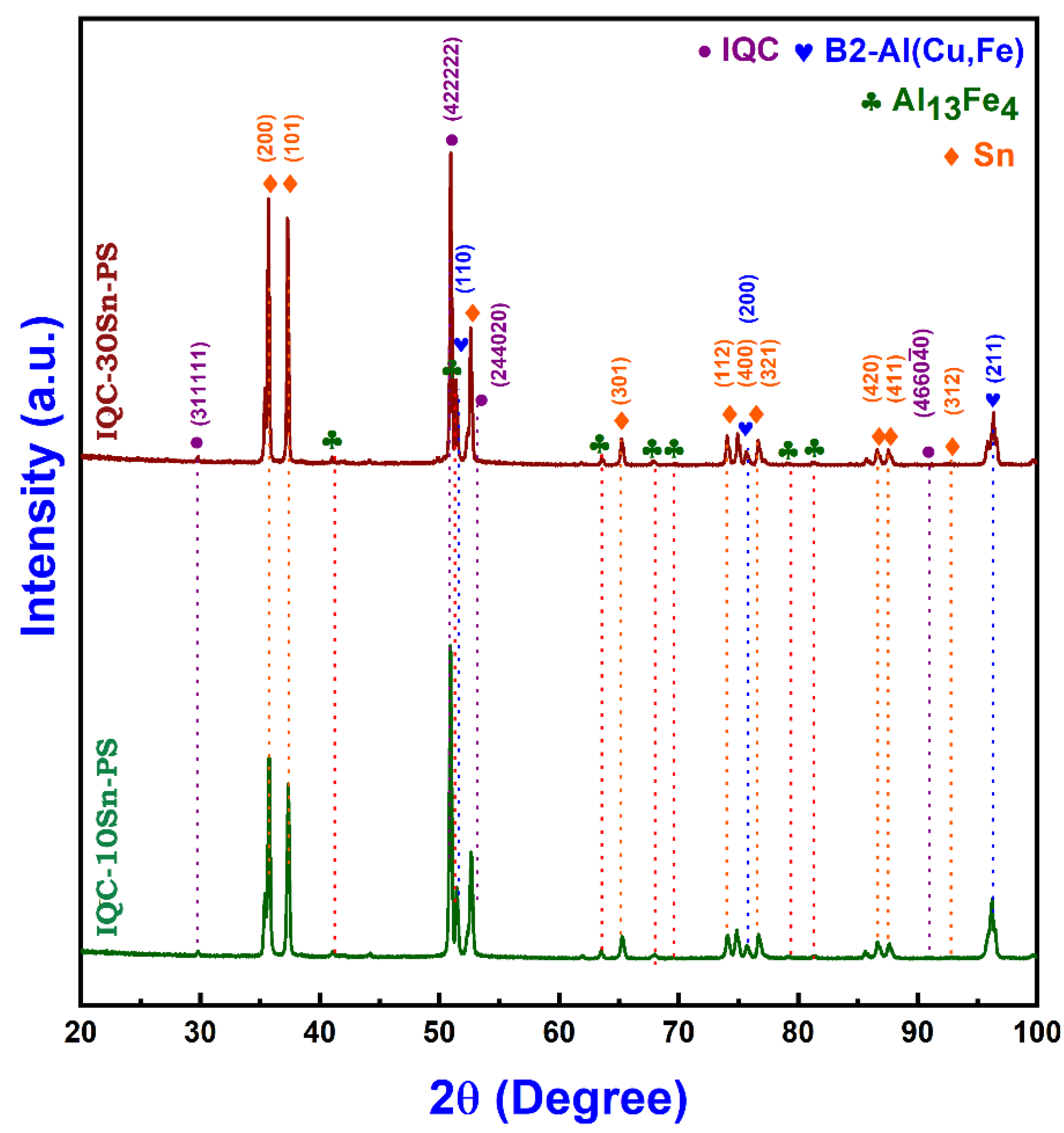


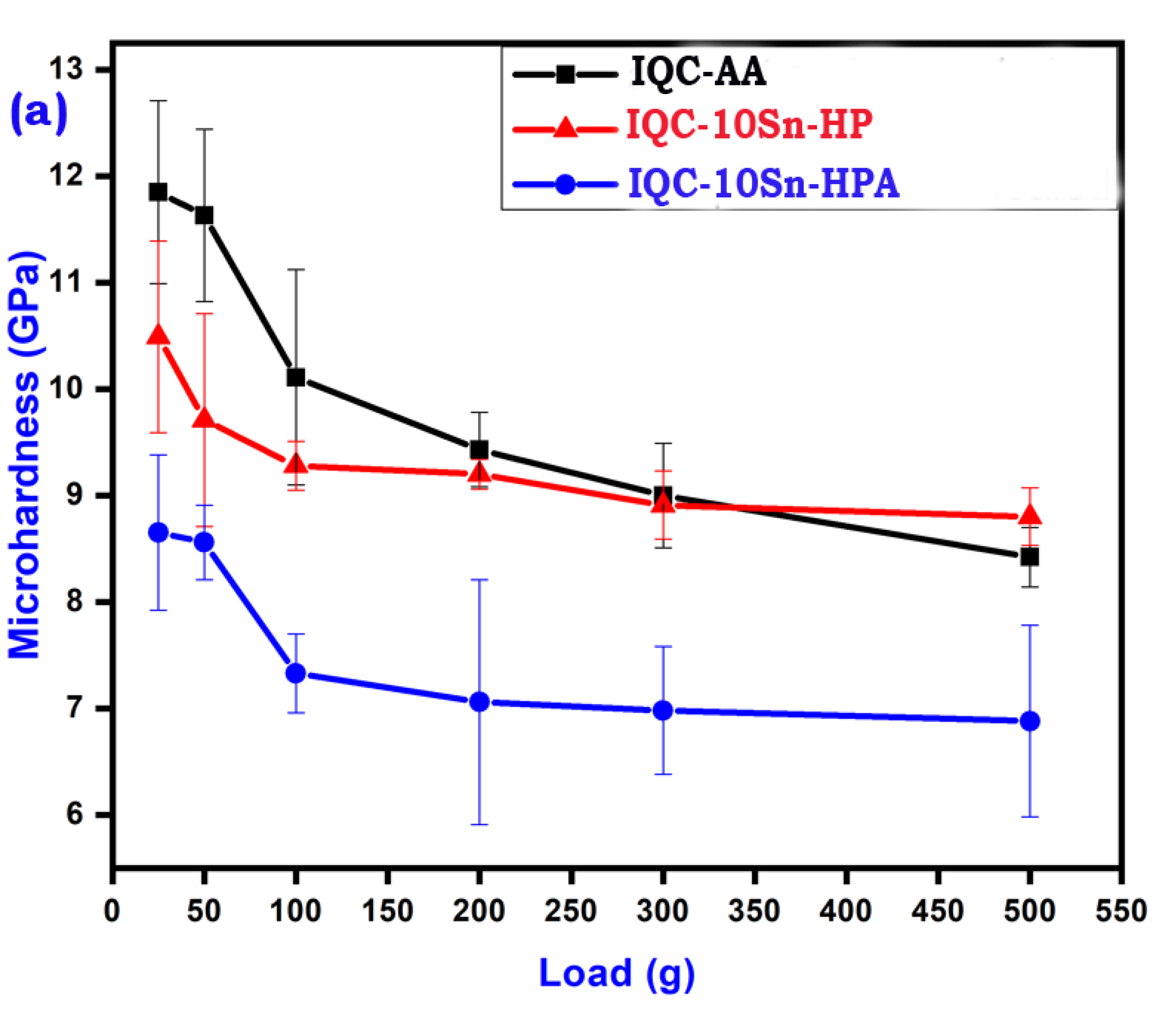

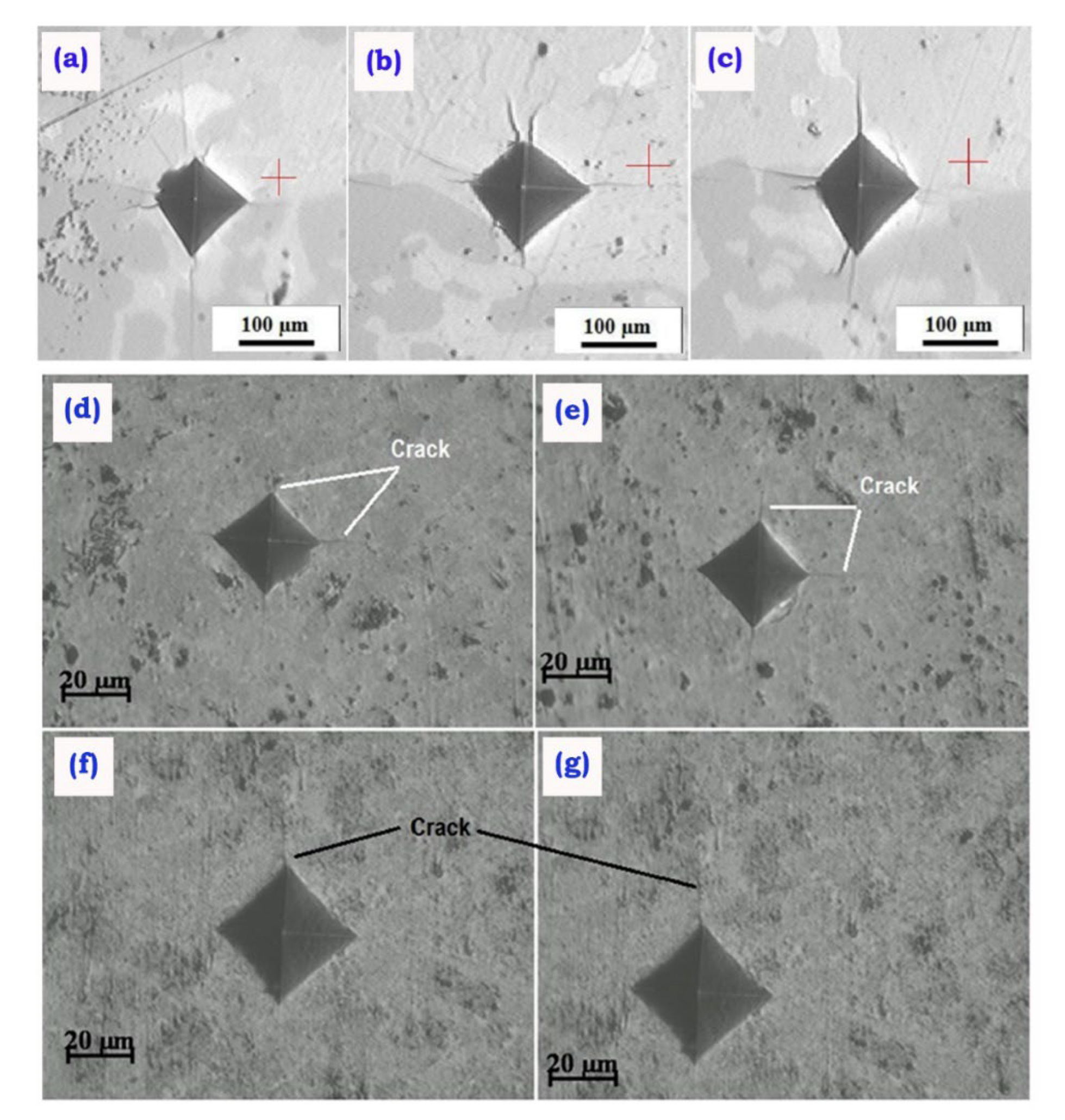
| Sample Condition | Microhardness (GPa) | ||
|---|---|---|---|
| Sample Designation | |||
| IQC-10Sn | IQC-20Sn | IQC-30Sn | |
| 10 h MM | 5.2 | 4.2 | 3.5 |
| 20 h MM | 6.0 | 4.9 | 4.1 |
| 30 h MM | 6.3 | 5.4 | 4.4 |
| 40 h MM | 7.3 | 6.4 | 5.3 |
| Sample Designation | Processing Condition | Density | Microhardness (at 200 g) in GPa | ||
|---|---|---|---|---|---|
| Experimental Density (g.cm−3) | Theoretical Density (g.cm−3) | Relative Density (%) | |||
| IQC-AA | As-cast and annealed | 4.19 | - | - | ~9.5 |
| IQC-10Sn-PS | Pressureless sintering (PS) | 2.78 | 4.49 | ~62 | ~7.2 |
| IQC-20Sn-PS | Pressureless sintering (PS) | 3.25 | 4.81 | ~68 | ~4.7 |
| IQC-30Sn-PS | Pressureless sintering (PS) | 3.77 | 5.11 | ~74 | ~4.1 |
| IQC-10Sn-HP | Hot pressing (HP) | 4.13 | 4.49 | ~92 | ~9.2 |
| IQC-10Sn-HPA | Hot pressing and annealing (HPA) | 4.18 | 4.49 | ~93 | ~7.1 |
| Sample Specification | Enhancement (%) | |
| As cast and annealed (IQC-AA) | 1.58 ± 0.27 | -- |
| IQC-10Sn-HP | 1.92 ± 0.12 | 22% |
| IQC-10Sn-HPA | 1.81 ± 0.16 | 15% |
Publisher’s Note: MDPI stays neutral with regard to jurisdictional claims in published maps and institutional affiliations. |
© 2022 by the authors. Licensee MDPI, Basel, Switzerland. This article is an open access article distributed under the terms and conditions of the Creative Commons Attribution (CC BY) license (https://creativecommons.org/licenses/by/4.0/).
Share and Cite
Shadangi, Y.; Shivam, V.; Chattopadhyay, K.; Mukhopadhyay, N.K. Powder Metallurgical Processing of Sn-Reinforced Al-Cu-Fe Quasicrystals: Structure, Microstructure and Toughening Behavior. J. Manuf. Mater. Process. 2022, 6, 60. https://doi.org/10.3390/jmmp6030060
Shadangi Y, Shivam V, Chattopadhyay K, Mukhopadhyay NK. Powder Metallurgical Processing of Sn-Reinforced Al-Cu-Fe Quasicrystals: Structure, Microstructure and Toughening Behavior. Journal of Manufacturing and Materials Processing. 2022; 6(3):60. https://doi.org/10.3390/jmmp6030060
Chicago/Turabian StyleShadangi, Yagnesh, Vikas Shivam, Kausik Chattopadhyay, and Nilay Krishna Mukhopadhyay. 2022. "Powder Metallurgical Processing of Sn-Reinforced Al-Cu-Fe Quasicrystals: Structure, Microstructure and Toughening Behavior" Journal of Manufacturing and Materials Processing 6, no. 3: 60. https://doi.org/10.3390/jmmp6030060
APA StyleShadangi, Y., Shivam, V., Chattopadhyay, K., & Mukhopadhyay, N. K. (2022). Powder Metallurgical Processing of Sn-Reinforced Al-Cu-Fe Quasicrystals: Structure, Microstructure and Toughening Behavior. Journal of Manufacturing and Materials Processing, 6(3), 60. https://doi.org/10.3390/jmmp6030060





